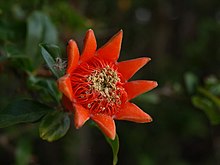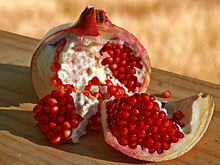pomegranate
| pomegranate | ||||||||||||
|---|---|---|---|---|---|---|---|---|---|---|---|---|
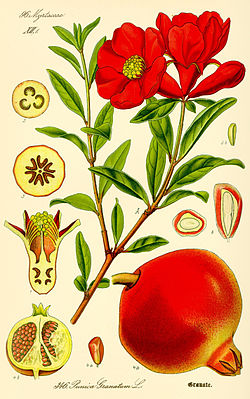
Pomegranate ( Punica granatum ), illustration |
||||||||||||
| Systematics | ||||||||||||
|
||||||||||||
| Scientific name | ||||||||||||
| Punica granatum | ||||||||||||
| L. |
The Pomegranate ( Punica granatum ) is a plant species that the family of the Lythraceae is attributed (Lythraceae). The genus Punica , which consists of two species, forms the subfamily Punicoideae (Horan.) SAGraham, Thorne & Reveal , some authors also have them as a separate monotypical family Punicaceae Horan . Their fruit is used in the kitchen. The distribution area of the pomegranate is in West to Central Asia ; today it is grown in the Mediterranean area , among other places . Originally, however, the pomegranate comes from what is now Iran, Afghanistan and northern India.
The generic name Punica is derived from the Latin punic (e) us , " punisch " and goes back to the Roman name for the Phoenicians . The German trivial name pomegranate (Middle High German also Margramapfel ) and the Latin species name granatum (about granatus from Latin granum , "grain", "core", "seed") was due to the numerous seeds contained in the fruits (Middle High German margramkern , "pomegranate kernels ") embossed.
description
Appearance and leaf
The pomegranate grows as a deciduous small tree and is often cultivated as a shrub ; it reaches heights of growth of up to 5 meters but also higher, is up to 3 meters wide and can live a few hundred years. The plant parts are bare. The bark is red-brown to gray, initially smooth, later furrowed, scaly. The young twigs are often square, later they turn gray-brown, terete and often end in a thorn. It is usually deciduous but also evergreen.
The opposite, also whorled or cross-opposite, whole-margined leaves are divided into petioles and leaf blades. The short petioles are 2 to 10 millimeters long. The simple, glossy, dark green on the underside, paler and more matt, waxy-leathery, partly asymmetrical leaf blade is lanceolate, lanceolate to obscurate or oblong with a narrowing blade base with a length of 2 to 9 centimeters and a width of 1 to 2 centimeters and blunt to round-pointed or pointed to prickly-pointed upper end. Stipules are absent, the veins are pinnate with a conspicuous central vein that is indented on the upper side and raised on the lower side. The young leaves are partly reddish-green, in autumn the leaves turn yellow.
There are also shrubby dwarf forms with a height of up to about 1 to 1.5 meters, e.g. B. the dwarf pomegranate tree (as a natural dwarf form Punica granatum var. Nana , as a cultivated form Punica granatum 'Nana').
blossom

The flowering time is usually in spring and summer , in China between March and July, in some regions 2 to 3 flowering times are common. The odorless flowers stand individually or in small groups at the ends of the branches. With a length of 3.5 to 7 cm and a diameter of 3 to 4 cm, the relatively large, mostly hermaphrodite urn-shaped or sterile male bell-shaped flowers are five to nine-fold with a double flower envelope . Also, there are intermediate, tubular, partially fertile flowers, with short pencil . The five to nine fleshy sepals that are fused, waxy-leathery, 2 to 4 cm long, are usually orange-red to light yellow. They are erect-triangular, with curved tips and basal form a calyx about 2 to 3 cm long and 1.5 cm wide. The five to nine red, orange, rarely white; with light yellow sepals and free, frilly, delicate petals are obovate with a length of 1.5 to 3 cm and a width of 1 to 2 cm with a rounded or blunt upper end. The very many stamens (up to over 300) are arranged in a circle and can protrude above the corolla. The dorsifix anthers are yellowish-white and the stamens are reddish-orange. The pomegranate is self- pollinated or externally pollinated.
The ovary below is 8 to 13 chambers . The fused carpels are superimposed in different whorls (usually 2 to 3), arranged in the ovary (coenokarp-synkarp). The placentation is central angular in the lower ones and parietal in the upper ones. The scar is head-shaped, three-lobed and lies deeper than the anthers.
There are also partly fertile "ornamental pomegranates" in partly different colors (pink, yellow), in which the stamens are completely or partly converted into more petals (petalody).
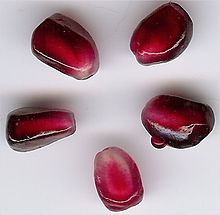
Fruit and seeds
The spherical, apple-like, initially green, later orange-red, red to yellow-green or yellowish-brown, with a diameter of normally 5 to 12 cm and 150–500 grams, but also up to 20 cm in size and 500 to over 1000 grams , also black-purple fruit is the borderline case of a leathery berry , since the pulp is not fleshy, but not lignified. This special fruit shape of the pomegranate is also known as Balausta (from balaustium or Greek balaustion , "blossom of the wild pomegranate tree").
The pomegranate is a false fruit (anthocarp) that is formed from the sepals, the flower base and the gynoeceum . It is crowned by the durable, sometimes a collar or a tip-shaped calyx lobes and the durable stamens. The whitish-light reddish, bitter, spongy mesocarp is - as with the citrus fruits - called "albedo". This is divided into individual chambers in which the seeds are located. The partition walls of these chambers are called "membranes".
The angular, polyhedral (polyhedral), ruby red to pink or yellowish-white seeds with a glassy, slightly translucent, juicy bounce, herb sweet seed coat ( sarcotesta , Arillus surrounded Testa) which readily burst when pressure. The seed coats are up to 15 mm long and approx. 5 to 10 mm wide, the actual, soft to hard seeds are egg-shaped and whitish and approx. 6 to 10 mm long and 2 to 5 mm wide. The fruit contains around 200 to over 1000 seeds. The thousand-grain mass without fleshy seed coat is approx. 30 to 40 grams, with it is approx. 370 to 400 grams.
The fruit opens irregularly when fully ripe. The fruits do not ripen after the harvest, they are classed as non-climacteric fruits . The time to fruit ripening after flowering is around 130 to 175 days or a little more.
Chromosome set
The number of chromosomes is 2n = 16 or 18.
distribution
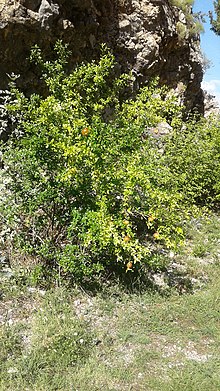
The distribution area of the pomegranate is in western to central Asia, from Turkey over the Caucasus ( Armenia , Azerbaijan , Georgia , southern Russia ) as well as Tajikistan , Turkmenistan and Uzbekistan east to Iran , Afghanistan , Pakistan and China .
In the Mediterranean and the Middle East , for example in Azerbaijan, Iran, Armenia, Egypt , Spain , Morocco , Tunisia , Syria , Palestine , Israel and Anatolia , the pomegranate has been cultivated for thousands of years (see also garden art ). In India the pomegranate is grown as a spice . The pomegranate is also found in Far East Asia. In Indonesia it is known as delima . It is also grown today in the USA, Chile , South Africa , Australia, Argentina and Brazil.
Some varieties of pomegranate thrive in regions of Central Europe with mild winter conditions. For example, a bush blooms in the front garden of the Museum of Decorative Arts in Budapest . In the course of the Spanish colonization, the pomegranate came to the Caribbean and Latin America . In general, however, the cultivated plant is sensitive to cold, temperatures below 12 ° C can damage it. In the resting phase, however, it can also endure short, not too strong frosts. It thrives best on sandy, well drained, fertile soils with long and hot summers up to an altitude of 2700 meters. It prefers a sheltered, sunny location and not too heavy rainfall and can withstand dry periods well.
use
Cultural history
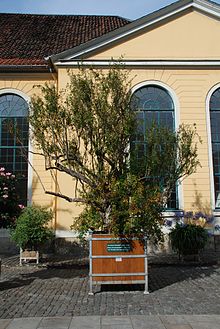
The archaeological tradition for pomegranates is poor, as the fruit is mostly consumed fresh and the water-rich skin bursts explosively when heated. Tests have shown that only old pomegranates with a relatively dried-out skin have a chance of charring and being passed on in this way. A charred pomegranate was found in the Early Bronze Age layers of Tel es-Sa'idiyeh in Jordan. In Cyprus and Egypt, colored glass vessels in the shape of a pomegranate were made in the late Bronze Age . The Uluburun ship found near Kaş in Turkey contained Cypriot storage jugs with over 1,000 pomegranate seeds.
Pomegranates were found as grave goods in a burial chamber of a high Egyptian official from the time of Ramses IV . In Tell Deir ʿAllā , Jordan, in the Jordan Valley, pomegranates were recovered in layers from the Iron Age. In the sacrificial shaft ( Favissa ) of an Iron Age temple near ʾEn Hazeva in Edom , stone pendants in the shape of pomegranate were found. A piece of pomegranate bark was found in the Abiʾor cave near Jericho , which served the rebels of the Bar Kochba uprising in the fall of 135 AD as a shelter, and a similar find comes from the Cave of the Spear near ʾEn Gedi in Israel. In Germany the pomegranate is archaeologically proven in medieval Constance .
Fruit growing
A multitude of forms have been bred, with some of the flowers and some of the fruits being the breeding goal.
The fruits are harvested from September to December . Harvested pomegranates can be stored or kept for several months at 0–5 ° C. The fruits can become dehydrated a bit, but they stay juicy inside. You can recognize old fruits by the fact that they are no longer round, but have taken on an angular shape as the skin has dried out.
preparation
It is best to cut off the tip about 1.5 cm high, then cut into the dividing walls of the individual chambers on the outside and then break the fruit open in a star shape. You can also cut out the tip and the stalk and cut off the bitter peel in sections on the skin and break it open or simply cut the fruit in half. You can also break open the pomegranate in a bowl of water. The kernels sink while the shell and white membranes float on the water, making them easy to separate. The seeds can be removed with your fingers or a spoon, or they can be loosened by tapping the outer skin of the divided fruit.
use
Pomegranates and their pressed juice are widespread in the Mediterranean region, the Middle East, the USA , southern Europe and, for some years, also in central and northern Europe. The juice is also used to make pomegranate wine, which is mainly exported from Armenia and Israel. The pulp or juice of the pomegranate is used to refine game or poultry dishes or in fruit salads.
The pomegranate peel was traditionally a dye for oriental carpets . It was also used in India to dye wool in shades of yellow and black. With an extract from the root of the pomegranate tree, deep dark blue shades can be created with an iron stain .
Grenadine syrup , which used to be made from pomegranate juice, gives Tequila Sunrise and various other cocktails its fruity taste and red color.
Iran is one of the main producers worldwide.
ingredients
The pomegranate and the inedible flowers and leaves contain large amounts of bioactive substances, in particular polyphenols , flavonoids , anthocyanins and gallotannins . The proportion of antioxidants in the shell is highest.
Shell and seeds
In addition to polyphenols, flavonoids, ellagitannins and anthocyanin precursors, various minerals such as potassium, calcium or magnesium as well as complex polysaccharides can be detected in the pomegranate peel . The edible seeds contain high amounts of gallotannins ( punicalagin , punicalin , gallagic acid or ellagic acid ) and anthocyanins (e.g. chrysanthemin or myrtillin ), which have strong anti-inflammatory and antioxidant effects. Various organic acids such as ascorbic acid , citric acid or malic acid have also been identified in the seed coat . The fleshy seed coat (arillus) consists largely of water (85%), along with sugar (10%), pectin (1.5%), but also polyphenols and anthocyanins. In the seed oil ( pomegranate seed oil , also pomegranate seed oil ), conjugated linoleic acids , etc. a. 65–85% punicic acid , with a smaller proportion also palmitic acid , oleic acid , linoleic acid , stearic acid , sterols , steroids and cerebrosides .
leaves
The leaves of a pomegranate are rich in minerals such as sodium, iron or potassium , depending on how far the leaf has developed. Older sheets contain e.g. B. a lot of calcium or iron, young leaves, however, more potassium. In general, tannins and glycosides , these with the aglycon apigenin , can also be detected.
Nutritional values of the fresh fruit
The fresh pomegranate is available from around June to December in German-speaking countries. In the first few months it comes mostly from Morocco, Israel or Tunisia, from October from Spain and Italy. Below are the energy contents and main components in 100 g edible portion:
- 316 kJ (74 kcal)
- 79.1 grams of water
- 0.7 g protein
- 0.6 g fat
- 16.1 g of carbohydrates
- 2.2 grams of fiber
The sugar contained in the pomegranate is divided into 7.9 g fructose and 7.2 g glucose .
Medical importance
Historically, pomegranates and pomegranate flowers were used to treat various diseases, such as diarrhea and ulcers. The root, bark and boiled peel were used as an anthelmintic against tapeworms until the Middle Ages . The active ingredients against tapeworms are the alkaloids such as Pelletierin . In Unani medicine , pomegranates are used to treat diabetes mellitus .
Since not only the fruit itself, but also other parts of the tree are rich in secondary plant substances with possible therapeutic significance, the plant has also come into the focus of scientific interest in recent decades. Numerous studies examined a possible positive effect of pomegranate juice on cardiovascular diseases and arthritis .
A meta-analysis of eight randomized placebo-controlled trials (RCTs) showed that the consumption of pomegranate juice reduced systolic and diastolic blood pressure. In a double-blind , placebo-controlled study on 45 patients with coronary artery disease , daily administration of 240 ml of pomegranate juice significantly increased myocardial blood flow. There were also positive effects in a study with patients with a narrowed carotid artery : after one year of eating pomegranate, the deposits on the carotid artery decreased by 35%, while they increased significantly in the control group.
Possible anti-inflammatory effects of pomegranate juice were examined in a meta-analysis of five RCTs . The authors conclude that pomegranate juice has no effect on lowering the CRP level in the blood, regardless of how long pomegranate juice has been consumed. A suggested effect on the lipid profile in the blood (e.g. cholesterol level or HDL-C) could not be shown by the evaluation of twelve RCTs.
The pomegranate has a particularly high number of polyphenols , even compared to red wine and blueberries , which could possibly be responsible for positive health effects. There are considerable differences in the quality and content of active polyphenols in pomegranate products. In an in vitro study , it was found that pomegranate juice inhibited the production of endogenous estrogens and inhibited the growth of estrogen- receptor -positive breast cancer cells by 80 percent without affecting the growth of healthy cells. Fermented pomegranate juice was twice as effective as fresh juice. The polyphenols from fermented pomegranate juice also have an effect on leukemia cells: the cells either regress into healthy cells ( redifferentiation ) or are driven into programmed cell death ( apoptosis ). In addition, the polyphenols prevent new blood vessels from forming ( neoangiogenesis ) - this makes it difficult for the tumor to spread.
The preventive and therapeutic effect of pomegranate juice on prostate cancer is the subject of intensive research; numerous studies have been carried out in this regard. In 2016, numerous studies were evaluated in a meta-analysis that examined the administration of various extracts and plant substances (e.g. lycopene , isoflavones or pomegranate juice) to prostate cancer patients. The PSA value (prostate-specific antigen) was evaluated as a central marker for possible therapeutic success. After application of the evaluation criteria, five of several studies were approved for the meta-analysis, including two placebo-controlled studies. The authors came to the conclusion that - although these five evaluated studies were of good quality - the case numbers were predominantly small and the investigation periods were short. The general problem is that no high-quality studies on the subject were published until 2016. Overall, the plant substances given are well tolerated and safe. There is also evidence that these can affect PSA dynamics. However, the data situation is too limited to make statements about a possible form of therapy (as a supplement or as a replacement for the classic form of therapy). Continuous use of pomegranate supplements to protect against prostate cancer is not recommended, especially when given in high doses.
Cultural history
religion
The pomegranate is the symbol of the Syrian goddess Atargatis .
Greek mythology
In ancient Greece , the pomegranate was attributed to the deities of the underworld , Hades and Persephone . The underworld god Hades kidnapped Persephone and took her with him to the underworld. Zeus , the father of the gods , decided that the girl could go back to her mother Demeter if she hadn't eaten anything in the underworld. Shortly before she returned, Hades put six pomegranate seeds into her mouth. Since she had now eaten something in the underworld, she had to rule a third of the year in the underworld with Hades and was allowed to spend the other two thirds with her mother Demeter.
The Trojan Paris ended the argument between the goddesses Hera , Athena and Aphrodite as to who was the most beautiful of them by handing Aphrodite an apple (pomegranate) (see judgment of Paris ).
Bible
The pomegranate is mentioned several times in the Tanach or Old Testament . It is considered one of the significant seven fruits with which the Promised Land of Israel was blessed. Pomegranates were according to the description in 2 Mos 28,33f. Lut part of the high priest's efod , which God is said to have ordered the Israelites to make. The closing knobs of the two iron columns Jachin and Boaz in front of the Solomonic Temple were adorned by two rows of pomegranates according to 1 Kings 7:18 Lut . King Saul stayed under a pomegranate tree after 1 Sam 14.2 Lut . In the Song of Solomon , the word pomegranate is used several times to emphasize the beauty of a woman (4.3 Lut , 4.13 Lut , 6.7 Lut ). Finally, the pomegranate tree can also be found in the prophets Joel 1,12 Lut and Hag 2,19 Lut .
Koran
The fruit is also mentioned in the Koran . The cattle (6th sura ), 99: “And it is He Who sends down water from the cloud, with it We bring forth all kinds of growth; With this we then produce greenery, from which We let rowed grain sprout, and from the date palm , from its flower umbels, hanging date grapes, and gardens with grapes, and the olive and the pomegranate - similar and dissimilar to each other. Look at their fruit when it bears fruit and when it ripens. Verily, in this are signs for those who believe. "
The cattle (6 Sure), 141: "It is He who can grow the gardens, with Reb trellises and without Rebspaliere, and the date palm and corn fields, are the fruits of various kinds, and the olive and the pomegranate , similar and unlike. Eat of their fruits when they bear fruit, but give Him the payment of them on the day of harvest and do not exceed the boundaries. Verily, He does not love the immoderate. "
The abode of orthodox believers after their death is a garden, "rushed through by brooks" ( Sura 2 , 25), in which numerous fruits grow. Palms, vines (2, 266; 17, 91; 36, 34) and pomegranates (55, 68) are mentioned as plants. "There will be fruit in both, and dates and pomegranates ."
The pomegranate in symbolism

The pomegranate is a symbol of life and fertility , but also of power ( imperial apple ), blood and death. In the Christian symbolic language, the pomegranate can stand for the church as an Ekklesia , as a community of believers. It also symbolizes that creation is contained in God's hand or providence. It is also a symbol of the priesthood , because it bears rich fruit in its hard shell (= asceticism of the priesthood). Because of this symbolism, the pomegranate appears in numerous medieval panel paintings . On the Stuppacher Madonna , created by Matthias Grünewald in 1517/1519, the baby Jesus plays with a pomegranate that his mother Maria hands him. This representation is in the tradition of the Marian title as "Mother of the Church" ( mater ecclesiae ), which has been documented since the High Middle Ages .
The Order of the Brothers of Mercy has a pomegranate with a cross as its emblem. The order was founded in the Spanish city of Granada , which has the pomegranate in its coat of arms, and the pomegranate is a symbol of Jesus in the Catholic Church .
The city of Granada, the province of the same name and many of its places as well as parts of the coat of arms of Spain have the pomegranate in the coat of arms , which represents the old kingdom of Granada after the takeover by the Christian rulers of Spain. The city of Granada may also be named after the pomegranate; the surrounding landscape is still an important cultivation area today.
In China , the pomegranate is a symbol of fertility and having a large number of children because of its many seeds . In Persian poetry , the pomegranate is also a metaphor for the female breast and healthy complexion.
The pomegranate in literature
The philosopher Jacques Derrida refers in one of his texts to the religious symbolism of the pomegranate.
The writer Stefan Andres published a volume of poetry in 1950 with the title "Der Granatapfel".
Others
- The pomegranate gave the garnet and the red gemstone varieties of the garnet group their name.
literature
- Bernd Brunner: The pomegranate book. Insel Verlag, Berlin 2018, ISBN 978-3-458-19444-6 ( Insel-Bücherei 1444)
- Michaela Döll: Medicinal fruit pomegranate. EA Herbig, Munich 2008, ISBN 978-3-7766-2548-6 .
- Stephanie Grabhorn : Pomegranate - fruit of the gods. Joy-Verlag, Oy-Mittelberg 2007, ISBN 978-3-928554-63-3 .
- Navindra P. Seeram, Risa N. Schulman, David Heber: Pomegranates: Ancient Roots to Modern Medicine. (= Medicinal and Aromatic Plants - Industrial Profiles. Volume 43). CRC Press, 2006, ISBN 0-8493-9812-6 .
- Zora Gienger: Pomegranate: Health. Nutrition. Wellness paperback. J. Kamphausen, 2010, ISBN 978-3-89901-287-3
- Klaus Thiele-Dohrmann : The crowned venus fruit. Stories about the pomegranate. Wilhelm Heyne, 1999, ISBN 3-453-16397-4 .
- Thomas Schauerte : pomegranate, pomegranate tree . In: RDK . Laboratory, 2014.
- TK Kim: Edible Medicinal And Non-Medicinal Plants. Volume 5: Fruits. Springer, 2013, ISBN 978-94-007-5652-6 , pp. 136-194.
Web links
- Punica granatum inthe IUCN 2013 Red List of Threatened Species . Posted by: Participants of the FFI / IUCN SSC Central Asian regional tree Red Listing workshop, Bishkek, Kyrgyzstan (11-13 July 2006), 2007. Accessed December 2, 2013.
- Description at Floridata (English).
- Description at hort.purdue.edu (English).
- Description of Punica granatum 'Nana' .
- Ingredients of the pomegranate tree .
- The apple of paradise at Christmas time (virtual exhibition) .
- Punica granatum in the Germplasm Resources Information Network (GRIN), USDA , ARS , National Genetic Resources Program. National Germplasm Resources Laboratory, Beltsville, Maryland.
Individual evidence
- ^ Punica granatum L. Retrieved March 28, 2020 .
- ^ Farmer, Ben: Afghanistan promotes pomegranates over opium poppies in farming overhaul . In: The Telegraph , November 20, 2008. Retrieved October 28, 2010.
- ^ Georg August Pritzel , Carl Jessen : The German folk names of plants. New contribution to the German linguistic treasure. Philipp Cohen, Hannover 1882, p. 319.
- ↑ Jürgen Martin: The 'Ulmer Wundarznei'. Introduction - Text - Glossary on a monument to German specialist prose from the 15th century. Königshausen & Neumann, Würzburg 1991 (= Würzburg medical-historical research. Volume 52), ISBN 3-88479-801-4 (also medical dissertation Würzburg 1990), p. 149.
- ↑ Punica granatum L. In: Lexicon of medicinal plants and drugs. on Spektrum.de, accessed on November 7, 2013.
- ↑ a b c d e f g h i j Haining Qin, Shirley A. Graham: Punica. Punica granatum Linnaeus. In: Wu Zheng-yi, Peter H. Raven, Deyuan Hong (Eds.): Flora of China. Volume 13: Clusiaceae through Araliaceae. Science Press / Missouri Botanical Garden Press, Beijing / St. Louis 2007, ISBN 978-1-930723-59-7 , p. 283.
- ^ A b D. Holland, K. Hatib, and I. Bar-Ya'akov: Pomegranate: Botany, Horticulture, Breeding. In: Jules Janick: Horticultural Reviews. Volume 35, Wiley, 2009, ISBN 978-0-470-38642-2 , pp. 127-191, online (PDF; 3.50 MB), Univ. of Calif. Division of Agric. and Nat. Res., Retrieved August 3, 2017.
- ↑ a b K. Dhinesh Babu: Floral Biology of Pomegranate (Punica granatum L.). In: Fruit, Vegetable and Cereal Science and Biotechnology. 4 (Special Issue 2), 2010, pp. 45–50, online (PDF; 217 kB).
- ^ Jules Janick: Plant Breeding Reviews. Volume 39, Wiley, 2015, ISBN 978-1-119-10771-2 , p. 341.
- ↑ Ibrahim Kahramanoğlu, Serhat Usanmaz: Pomegranate Production and Marketing. CRC Press, 2016, ISBN 978-1-4987-6850-4 , p. 4.
- ↑ a b R. Riyahi, S. Rafiee et al .: Some physical characteristics of pomegranate, seeds and arils. In: Journal of Agricultural Technology. Vol. 7 (6): 2011, pp. 1523-1537, online (PDF; 476 kB).
- ↑ a b How many seeds does a pomegranate have? at aquaphoenix.com, accessed August 6, 2017.
- ↑ Heinrich Marzell : Dictionary of German plant names. 5 volumes, Leipzig, from volume 3 Stuttgart / Wiesbaden, volume 3, p. 1193.
- ↑ Jürgen Martin: The 'Ulmer Wundarznei'. Introduction - Text - Glossary on a monument to German specialist prose from the 15th century. Königshausen & Neumann, Würzburg 1991 (= Würzburg medical-historical research. Volume 52), ISBN 3-88479-801-4 (also medical dissertation Würzburg 1990), p. 114 ( balaustie , balaustia : pomegranate blossoms from Punica granatum L.).
- ↑ Hjalmar Frisk : Greek etymological dictionary. 3 volumes, Heidelberg 1960–1972 (= Indo-European Library , 2nd series); Reprint (declared as “second edition”) ibid 1973, volume 1, p. 214.
- ^ Yearbook of the German Archaeological Institute. Vol. 110, 1995, De Gruyter, 1996, ISBN 3-11-014523-5 , p. 20.
- ↑ Pomegranate species (Punica granatum L.); Guideline (PDF; 312 kB), at plantauthority.gov.in, accessed on August 3, 2017.
- ↑ a b E. Shaygannia et al .: A Review Study on Punica granatum L. . In: J Evid Based Complementary Altern Med . 21, No. 3, 2016, pp. 221-227. doi : 10.1177 / 2156587215598039 . PMID 26232244 .
- ^ Caroline R. Cartwright: Grapes or raisins? An early Bronze Age larder under the microscope. In: Antiquity. 77 (296), 2003, pp. 345-348, doi: 10.1017 / S0003598X00092322 .
- ^ Glass vessel in the form of a pomegranate on culturalinstitute.britishmuseum.org.
- ^ C. Bachhuber: Aegean interest on the Uluburun ship. In: American Journal of Archeology. 110 (3), 2006, pp. 345-363, JSTOR 40024547 ; Cheryl Haldane: Direct evidence for organic cargoes in the Late Bronze Age. In: World Archeology. 24 (3), 1993, p. 335, JSTOR 124713 .
- ^ R. Neef: Planten. Opgravingen te Deir Alla in the Jordaan Valley. Rijksmuseum van Oudheden, Leiden 1989, pp. 30-37.
- ^ Sara Ben-Arieh: Temple Furniture from a Favissa at ʾEn Hazeva. In: ʾAtiqot. 68, 2011, ISBN 978-965-406-281-7 , pp. 107-175.
- ↑ ME Kislev: Vegetal food of Bar Kokhba rebels at Abi'or Cave near Jericho. Festschrift for Professor van Zeist. In: Review of Palaeobotany and Palynology. Volume 73, No. 1-4, September 30, 1992, Plate 1, doi: 10.1016 / 0034-6667 (92) 90053-J .
- ↑ Orit Simchoni, Mordechai E. Kislev: Relict Plant Remains in the 'Caves of the Spear. In: Israel Exploration Journal. 59 (1), 2009, p. 47. JSTOR 27927214 .
- ^ H. Küster: Medieval plant remains from Constance on Lake Constance. In: U. Körber-Grohne, H. Küster (Ed.): Archäobotanik. Dissertationes Botanicae. Volume 133. Borntraeger, 1989, ISBN 978-3-443-64045-3 , pp. 201-216.
- ↑ Christoph Bachmann: The pomegranate: Punica granatum . In: Phytotherapy . No. 2, 2007, p. 32–35 ( rosenfluh.ch [PDF; 56 kB ; accessed on December 22, 2010]).
- ↑ Walid Elfalleh et al .: Total phenolic contents and antioxidant activities of pomegranate peel, seed, leaf and flower . In: J. Med. Plants Res . 6, No. 32, 2012, pp. 4724-4730. doi : 10.5897 / JMPR11.995 .
- ↑ a b c d e P. Sharma et al .: Pomegranate for Prevention and Treatment of Cancer: An Update . In: Molecules . 22, No. 1, 2017, pp. 4724-4730. doi : 10.3390 / molecules22010177 . PMID 28125044 .
- ^ Wilhelm Halden, Adolf Grün : Analysis of fats and waxes. Volume 2, Springer, 1929, ISBN 978-3-642-89318-6 , p. 677.
- ↑ Kim: p. 145.
- ↑ P. Aruna, RP Singh et al. a .: Health Benefits of Punicic Acid: A Review. In: Comprehensive Reviews in Food Science and Food Safety. Volume 15, Issue 1, 2016, pp. 16-27, doi: 10.1111 / 1541-4337.12171 .
- ↑ German Research Institute for Food Chemistry, Garching (ed.): Food table for practice . The little souci · specialist · herb. 4th edition. Wissenschaftliche Verlagsgesellschaft, Stuttgart 2009, ISBN 978-3-8047-2541-6 , p. 410 .
- ↑ Konrad Goehl : Observations and additions to the 'Circa instans'. In: Medical historical messages. Journal for the history of science and specialist prose research. Volume 34, 2015 (2016), pp. 69-77, here: p. 71.
- ↑ Entry on Pelletier. In: Römpp Online . Georg Thieme Verlag, accessed on April 19, 2019.
- ↑ Entry on female pseudopellet. In: Römpp Online . Georg Thieme Verlag, accessed on April 19, 2019.
- ↑ a b M. Aviram et al .: Pomegranate juice consumption for 3 years by patients with carotid artery stenosis reduces common carotid intima-media thickness, blood pressure and LDL oxidation . In: Clin Nutr . tape 23 , no. 3 , 2004, p. 423-433 , doi : 10.1016 / j.clnu.2003.10.002 , PMID 15158307 .
- ↑ M. Shukla et al .: Consumption of hydrolyzable tannins-rich pomegranate extract suppresses inflammation and joint damage in rheumatoid arthritis. In: Nutrition. 24 (7-8), Jul-Aug 2008, pp. 733-743, doi: 10.1016 / j.nut.2008.03.013 .
- ↑ A. Sahebkar et al .: Effects of pomegranate juice on blood pressure: A systematic review and meta-analysis of randomized controlled trials . In: Pharmacol Res. . 155, 2017, pp. 149-161. doi : 10.1016 / j.phrs.2016.11.018 . PMID 27888156 .
- ↑ MD Sumner et al .: Effects of pomegranate juice consumption on myocardial perfusion in patients with coronary heart disease. In: Am J Cardiol. Volume 96, No. 6, 2005, pp. 810-814. PMID 16169367 .
- ↑ A. Sahebkar et al .: Effects of supplementation with pomegranate juice on plasma C-reactive protein Concentrations: A systematic review and meta-analysis of randomized controlled trials . In: Phytomedicine . 23, No. 11, 2016, pp. 1095-1020. doi : 10.1016 / j.phymed.2015.12.008 . PMID 26922037 .
- ↑ A. Sahebkar et al .: Lipid profile changes after pomegranate consumption: A systematic review and meta-analysis of randomized controlled trials . In: Phytomedicine . 23, No. 11, 2016, pp. 1103–1120. doi : 10.1016 / j.phymed.2015.12.014 . PMID 26857863 .
- ↑ Navindra P. Seeram et al .: Comparison of antioxidant potency of commonly consumed polyphenol-rich beverages in the United States. In: Journal of Agricultural and Food Chemistry. Volume 56, No. 4, 2008, pp. 1415-1422. doi: 10.1021 / jf073035s full text PDF. ( Memento of the original from March 4, 2016 in the Internet Archive ) Info: The archive link was inserted automatically and has not yet been checked. Please check the original and archive link according to the instructions and then remove this notice.
- ↑ M. Fischer-Zorn, V. Ara: Pomegranate juice - chemical composition and possible adulterations. In: Liquid fruit. 2007, 08, pp. 386-393.
- ↑ ND Kim et al .: Chemopreventive and adjuvant therapeutic potential of pomegranate (Punica granatum) for human breast cancer. In: Breast Cancer Res Treat. Volume 71, No. 3, 2002, pp. 203-217, PMID 12002340 .
- ↑ S. Kawaii, EP Lansky: Differentiation-promoting activity of pomegranate (Punica granatum) fruit extracts in HL-60 human promyelocytic leukemia cells. In: Journal of Medicinal Food. Volume 7, 2004, pp. 13-18. PMID 15117547
- ↑ MD van Die et al .: Phytotherapeutic interventions in the management of biochemically recurrent prostate cancer: a systematic review of randomized trials. In: BJU Int. 117 Suppl 4: 2016, pp. 17–34, doi: 10.1111 / bju.13361 . Epub Feb 22, 2016; PMID 26898239 .
- ↑ Stiftung Warentest: Pomegranate food supplements - Old fruit rediscovered - Report - Stiftung Warentest. August 27, 2009. Retrieved July 18, 2017 .
- ↑ On the seven main fruits of the Land of Israel (wheat, barley, grapes, figs, pomegranates, olives and dates) see Susanne Lechner-Masser: Biblical figures in Jewish religious instruction . Schöningh, 2017, ISBN 978-3-506-78468-1 , pp. 240 ( limited preview in Google Book search).
- ↑ z. B. in Theophilus of Antioch , Ad Autolyticum 1, 4.
- ↑ Jürgen Ehlers (ed. And trans.): Abū'l-Qāsem Ferdausi: Rostam - The legends from the Šāhnāme. Philipp Reclam jun., Stuttgart 2002, ISBN 3-15-050039-7 , p. 365.
- ↑ Jacques Derrida : Faith and Knowledge - The Two Sources of "Religion" at the Limits of Mere Reason. In: Jacques Derrida , Gianni Vattimo (ed.): The religion. Suhrkamp, Frankfurt am Main 2001, ISBN 978-3-518-12049-1 , pp. 77 and 105.


